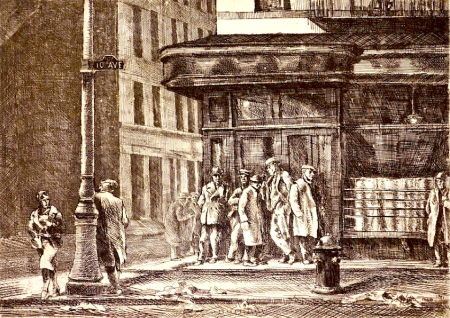Shop girls, down and out men, lone pedestrians on the way to the elevated train—from the 1930s to the 1980s, Isabel Bishop observed these men and women from her Union Square artist’s studio, painting them in soft tones that reveal their humanity and fragility.

Born in 1902 in Cincinnati, Bishop moved to Manhattan at age 16 to attend the New York School of Applied Design for Women. She then took classes at the Art Students League, developing her talents as a printmaker and painter.
Influenced by early Modernists like Robert Henri and old masters such as Rubens, she became associated with the 14th Street School, a group of realist artists that included Reginald Marsh and Raphael Soyer.

Bishop married in 1934 and moved to Riverdale. But she kept her studio first at Nine West 14th Street and then another at 857 Broadway. The Union Square area in those pre- and postwar decades was home to lower-end department stores, offices, and cheap entertainment venues.
And of course, there was the park itself, a gathering place for everyone from soap-box agitators to workers on their lunch hour to derelict men with no where else to go.

The subject matter right outside her studio suited Bishop perfectly.
“It was in New York’s pulsating environment that Bishop combined her admiration for the old masters with a contemporary taste for urban realism,” states the National Museum of Women in the Arts.

“With her discerning eye, she portrayed ordinary people in an extraordinary manner, often monumentalizing her figures within spaces that barely created context or indicated a location.”
“She chose average models from the streets of Manhattan and often rendered them in a state of physical activity—a sharp departure from the idealized, passive nudes of previous traditions.”
[“Fifteenth Street and Sixth Avenue,” 1930]

Bishop focused many of her paintings on women—the otherwise ordinary women who passed through Union Square, coming in and out of offices or catching a train. Neither mothers nor sex symbols, they “exist for themselves,” as one critic put it.
“On the street corner, in the automat, in the subway and on park benches in fine weather, Miss Bishop proved herself a perceptive observer,” wrote the New York Times in her obituary. “For young women in the big city who were as yet unmarked by life, she had a particular feeling.”
[“Fourteenth Street,” 1932]

As time went on, Bishop’s style seemed to become more muted, with figures of women in what looks like perpetual motion—perhaps a comment on the rise of women in American society.
 Bishop kept her Union Square studio until 1984; she died in 1988. This self-portrait was done in 1927, when she was just 25.
Bishop kept her Union Square studio until 1984; she died in 1988. This self-portrait was done in 1927, when she was just 25.
She isn’t as well-known as she should be, but her amber-hued men and women caught in ordinary, fleeting moments speak to the anonymity and motion of urban life in the 20th century.
[Images 1-4; 6: onlinebrowsing.com; Image 5 and 7, dcmooregallery.com]




















